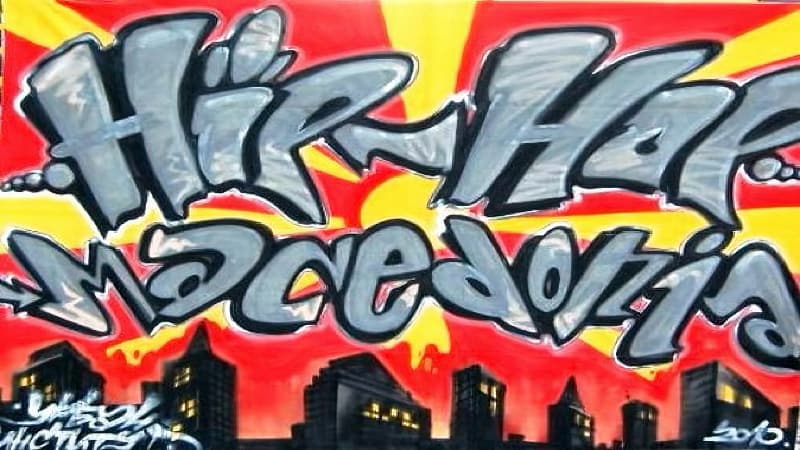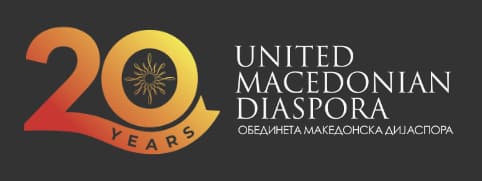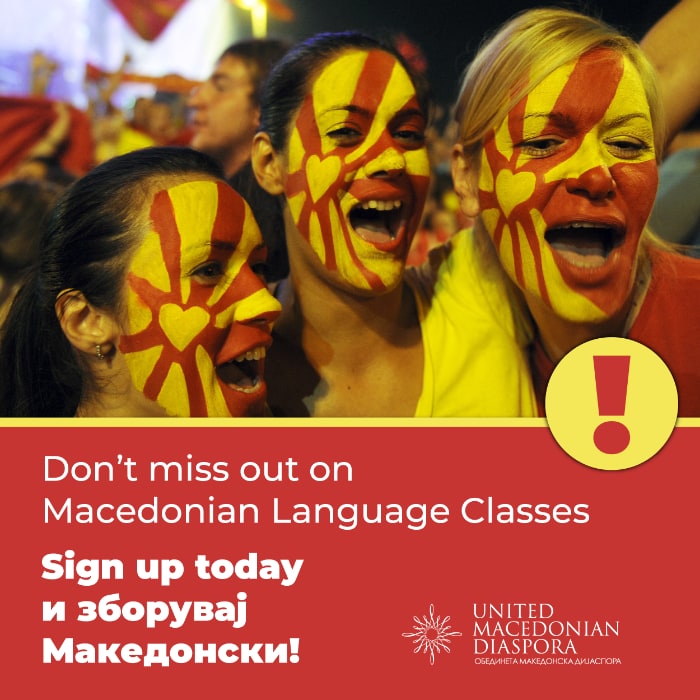Macedonian Heritage
The Macedonian Heritage Preservation Fund
The Macedonian Heritage Preservation Fund, established by the United Macedonian Diaspora, regularly evaluates proposals and awards grants to programs that delve into the history of Macedonia and Macedonian immigration and people, and contribute to the preservation and protection of our rich Macedonian cultural heritage. Past UMD-supported projects have included folklore dancing festivals, art exhibits, film festivals, movie screenings, language study programs, conferences, music concerts, tours, and book promotions.
Macedonian Heritage Month
Every September, UMD commemorates Macedonian Heritage Month to honor the generations of Macedonians who have woven their heritage into the fabric of history, culture, and society in our Diaspora homelands. Every year, UMD undertakes a range of projects celebrating Macedonian culture, fostering connections with our family and friends while preserving our cherished traditions.
Macedonian Language
The Macedonian language, spoken by approximately 4 million people worldwide, serves as the cornerstone of the Macedonian nation and identity. Throughout history, Macedonians have made significant efforts to preserve our linguistic heritage. The Cyrillic alphabet, developed by the Macedonian brothers Saints Kiril and Metodij from Solun (Thessaloniki) and their disciples Saint Clement of Ohrid, and Saint Naum of Ohrid, is not only the official script of the Macedonian language but used by more than 250 million people across 50 languages and is the 6th most popular writing script on the planet.
In 2009, UMD proudly sponsored the 7th Macedonian-North American Conference on Macedonian Studies at the University of Utah, and in 2015, the 9th Conference at the University of Chicago. These initiatives have acted as key platforms for preserving and promoting the Macedonian language. UMD and its UMD Australia entity have supported Macedonian language instruction efforts in Greece.
In partnership with the Macedonian Language E-Learning Center, UMD offers online classes tailored to beginner, intermediate, and advanced students of all ages. These classes, led by experienced English-speaking instructors, are conducted via Zoom and run twice weekly for eight-week sessions. Class durations vary based on the age of participants.
We invite you to Sign up today, зборувај Македонски, and take advantage of this wonderful opportunity to honor and celebrate our language, all while deepening your connection to our homeland.
Macedonian Cuisine
Many cultures express themselves through food. Macedonians have their special ways of taking basic ingredients, adding love, and turning them into traditional dishes handed down from generation to generation.
Do you remember eating at your grandma’s house? There is no such a thing as “I am full.” Luckily, our cuisine is so rich in flavor and tradition that sometimes it is hard to stop ourselves. From gomleze, sopska salad, ajvar to tavche-gravche, stuffed peppers, sarma, and many more delicious recipes, Macedonian cuisine is easy to recognize by the distinctive and appetizing food.
Every region in Macedonia has their own signature dish, but don’t be afraid to try them all. Make sure you pair your meal with rakilja or wine, for the full Macedonian experience.
Nazdravje!

Macedonian Music
Macedonian music and folklore have been classified as one of the greatest and rarest kinds of music on earth. The beating rhythm in ⅞ has been captivating hearts worldwide, propelling Macedonian artists to prominent stages and global recognition. Macedonian music represents a mix of emotions, struggle, hope, and happy moments. It includes lyric songs, epic songs, labor songs, ritual songs, humorous songs, circle dance (“oro”), the old urban style called Čalgija (not to be confused with chalga), etc.
Popular traditional songs are: Kaleš bre Angjo, Slušam kaj šumat šumite, Biljana platno beleše, Dafino vino crveno, Narode Makedonski, Zemjo Makedonska and many others. Often referenced oro dances are Teškoto from the village of Galičnik, Kalajdžiskoto, Komitskoto (The Dance of the freedom fighters), and others. An internationally acclaimed professional folklore association is the award-winning Tanec.
A clarinet or saxophone, a drum set, a bass guitar, an accordion, and a guitar make up a Macedonian folk orchestra. Sometimes, modern synthesizers and drum machines are added as well. In Macedonia, these orchestras are particularly well-liked. Virtuoso accordion players Goran Alachki and Skender Ameti, as well as clarinetist Miroslav Businovski, are popular members.
A dajre (tambourine) and tarabuka (hourglass drum) serve as the percussion for the ut (lute), kanun (zither), clarinet, and violin in the urban style known as calgija. Some traditional musicians still exist despite the fact that contemporary musicians have modified the calgija into a range of hard and gentle, classical and pop tones. Tale Ognenovski, who performs a wide range of traditional and contemporary sounds, has arguably had the largest impact in recent years.
Macedonian Classical Music

Simon Trpceski
In Skopje, the Mokranjac School of Music was founded in 1934. Along with having a reputable choir, it was well-known for the composers who were involved in its founding, including Trajko Prokopiev and Todor Skalovski.
Simon Trpceski, a pianist, and Queen Elizabeth’s favorite, is currently one of the world’s most well-known classical musicians. Other noteworthy opera singers include Neven Siljanovski, Blagoj Nacoski, Ana Durlovski, Igor Durlovski, and Boris Trajanov. The pianist Hristijan Spirovski, who is of Macedonian descent but was born in Australia, is a prominent musician from the diaspora. Borjan Canev, Sasho Tatarchevski, Bisera Chadlovska, and Oliver Balaburski are some of the most well-known conductors, and the most notable instrumentalists are the violinists Ljubisha Kirovski, Oleg Kondratenko, and Russian-born Anna Kondratenko, the saxophonist Ninoslav Dimov, the clarinetist Stojan Dimov, the bassists Velko Todevski and Petrus Petru Darija Andovska, Jana Andreevska, Goce Kolarovski, Tome Mancev, Stojan Stojkov, Damjan Temkov, Valentina Velkovska, Soni Petrovski, Goran Nachevski, and Boris Svetiev are a few of the composers who contributed to the work.
Macedonian Pop Music

Toše Proeski
There are several well-known pop music artists in Macedonia, including Tose Proeski as the most famous Macedonian singer, Karolina Goceva, Maja Odzaklievska, Ljupka Dimitrovska, Rebeka, Gjoko Gjorchev, Elena Risteska, Andrea, Vlatko Ilievski, Vlatko Lozanoski, DNK, Dani Dimitrovska, Kaliopi, Tamara Todevska, Darko Dimitrov, Damir Imeri, Aleksandar Masevski, and Grigor Koprov are notable pop music composers, producers, and arrangers. Many musicians, such as Jovan Jovanov and Miyata, are well-known for both their singing and songwriting.
Zabavna Muzika, the first example of Macedonian pop music, initially appeared in the middle of the 20th century. The most well-known performers from the older age include Dragan Mijalkovski, Verica Risteska, and Zafir Hadzimanov.
Macedonian Rock Music

Leb i Sol
Leb i Sol was one of the most well-known and successful rock bands in the Western Balkans as well as Macedonia. They created their own unique style by fusing rock music with traditional music, jazz fusion, and other genres. As a result, they rose to become one of the top groups in the Western Balkans. Following their breakup, the band’s guitarist Vlatko Stefanovski, bassist Bodan Arsovski, keyboardist Kokan Dimuevski, and drummer Garabet Tavitijan all launched lucrative solo careers. They came together one more for a reunion tour in 2006 to commemorate their band’s 30th anniversary. Without Stefanovski and Tavitjan’s involvement, a new album called “I taka nataka” was recorded in 2008 with a different line-up.
The Beatles and other artists of the 1960s had a big influence on another renowned group, Bisbez. It was created in 1964 by combining the musical styles of two earlier groups, Biseri (meaning Pearls) and Bezimeni (Nameless). A few noteworthy bands from the 1970s included Pu, Madrigali, Ilinden 903, Den za Den, Leva patika, Triangl, and Torr. Most of them liked jazz-rock, funk rock, hard rock, progressive rock, folk rock, and symphonic rock. Punk rock first appeared in the late 1970s.
Macedonian Hip Hop Music

Graffiti Hip Hop Makedonija
Beginning in the 1980s in the former Socialist Republic of Macedonia, the genre of hip hop saw significant growth after the country’s declaration of independence. The rock group Super Nova from Skopje was one of the first critically recognized groups to use rap music elements in several of its songs. The trio recorded various rap music tracks, including Hip-hop blues, Rap, Vero, and others, some of which included pop, rock, funk, reggae, or other elements, for the music production division of the Macedonian Radio-Television.
SAF (Sakam Afro Frizura), a hip hop group founded in 1993, was among the most popular in the nation. It consists of the turntablist and backup DJ for the group, Goce Trpkov, as well as the emcees Smilen Dimitrov and Mitko Gatarovski aka Pikisipi. The hip-hop scene in Macedonia is still growing. Aleksandar and Slavcho Koviloski are brothers who are well-known for their political and social involvement in hip hop and who have been a part of organizations like Braka Po Krv and Klan Istok for a long time. The brothers have been giving lectures in high schools, universities, and cultural institutions throughout Macedonia since 2005. They had written three books about hip-hop and urban culture by 2008, which was unheard of on the Balkans.
Macedonian Electronic Music

PMG Collective
The most well-known electronic performers include Gotra, Robotek, Galoski, the PMG Collective, and Kiril Djajkovski (a former member of Bastion). The nightlife in Macedonia is well-developed, particularly in Skopje. The nation has a number of festivals with international DJs, many of which take place during the summer on Ohrid Lake. One of the most well-liked electronic music subgenres in Macedonia is psychedelic trance, and there are many internationally well-known and successful psytrance acts from Macedonia, such as Fobi, Kala, Yudhisthira, AntHill (a joint project between Kala and Yudhisthira), Blisargon Demogorgon, Atriohm, Zopmanika, Demoniac Insomniac, Ego etc.
Macedonian Jazz Music

Toni Kitanovski
The jazz scene in Macedonia is well-liked. Toni Kitanovski on guitar, Zoran Madzirov on vibraphone, Dragan Soldatovic-Labish and Simon Kiselicki on piano, and bands like Tavitjan Brothers, Sethstat, Letecki Pekinezeri, and La Colonie Volvox are just a few of the well-known and acclaimed jazz musicians and ensembles. Every year, the Skopje Jazz Festival takes place helping the Macedonian scene listen to quality and world-established jazz.




